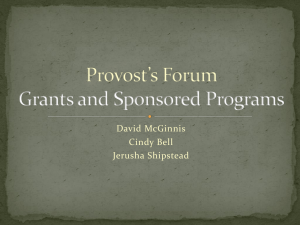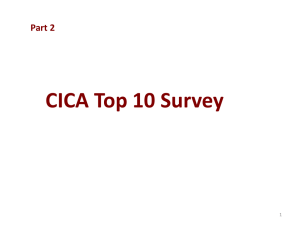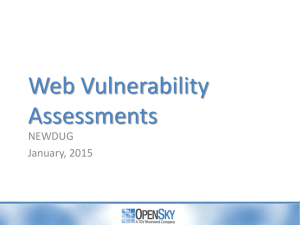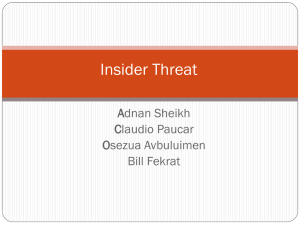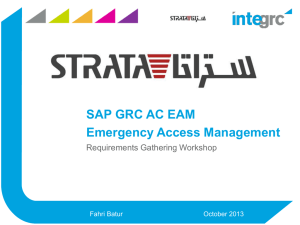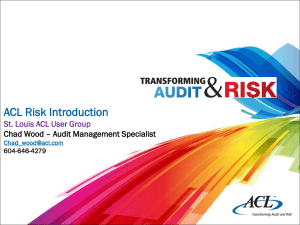การบริหาร ความเสี่ยง
advertisement
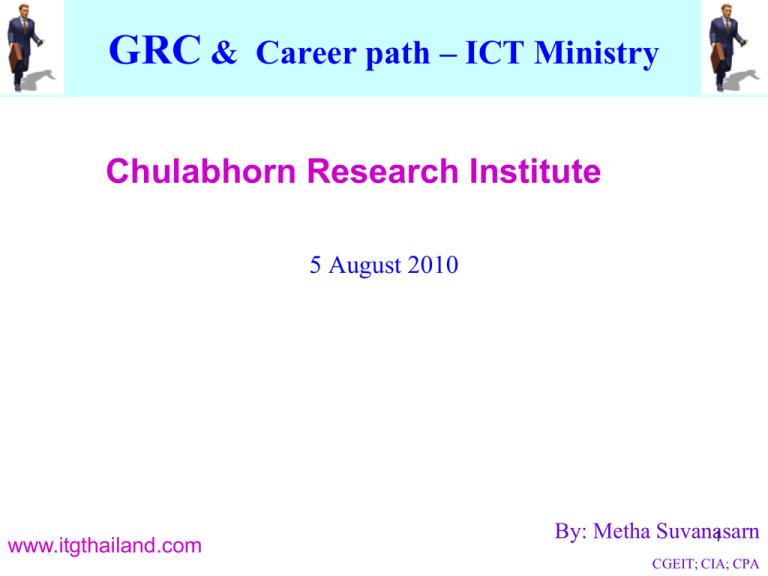
GRC & Career path – ICT Ministry Chulabhorn Research Institute 5 August 2010 www.itgthailand.com By: Metha Suvanasarn 1 CGEIT; CIA; CPA หลายคนคิดทีจ ่ ะเปลีย ่ นโลก แต่ไม่มใี ครเลยทีค ่ ด ิ จะเปลีย ่ นต ัวเอง ลีโอ ตอล์สตอย ATTITUDE can change the World ท ัศนคติ สามารถเปลีย่ นแปลงโลกแห่งการบริหารได้ GRC : Value Creation for Effectiveness & Efficiency of Operations Sustainable growth 2 การบริหาร ความเสี่ ยง (ERM) 1/1 1 การบริหาร IT Governance การกากับดูแลกิจการที่ดี (Corporate Governance) 4 GRC การตรวจสอบภายใน (RBIA) 3 การควบคุมภายใน (COSO) GRC : Holistic Understanding for CG & ITG+GRC and CIO / C-Levels กรอบการกากับดูแลกิจการที่ดี CG&ITG และการบริหารเพือ่ สร้ างคุณค่ าเพิม่ กับ Soft Controls Tone at the Top ระดับวิสัยทัศน์ โดยคณะผูบ้ ริ หารระดับสู ง หรื อคณะกรรมการบริ หาร ระดับการบริ หาร โดยผูอ้ านวยการ และ รองผูอ้ านวยการ ระดับปฏิบัติการ โดยผูบ้ ริ หารลงไปถึง ผูป้ ฏิบตั ิ ระบบงาน ภายนอก การกากับ ดูแลกิจการที่ดี ขององค์กร (จิตวิญญาณ/ความยั่งยืน) การบริ หาร IT Governance Soft controls ระบบการ ระบบการควบคุม ระบบการ บริ หารความเสี่ ยง (ศู นย์ รวมประสาท) ตรวจสอบภายใน (ภูมิค้ มุ กัน) (การตอบสนอง) ระบบเทคโนโลยีสารสนเทศ-IT (โครงกระดูก) ระบบงาน ส่ วนหน้า ระบบงาน ส่ วนกลาง ระบบงาน ส่ วนหลัง Where are we ..to GRC ? Evolution of three ways of managing companies: by instructions, by objectives and by values Trend for manager to become leaders and facilitators MBV Organizational Complexity Trend towards Product Quality and clients’ satisfaction XXI Century MBO 1980 MBI 1960 Need for “Organizational Development” Trend towards autonomy and professional responsibility MBI = Management by Instructions; MBO = Management by Objectives; Source : Management by Values : Simon L. Dolan, MBV = Management by Values Salvador Garcia and Bonnie Richley Source : Sun Microsystems, Inc. Trend towards team, Networks & flat structure GRC : Value Creation for Effectiveness & Efficiency of Operations Composite Model Good Governance Self Discipline Market Discipline Regulatory Discipline Governance is about identifying and controlling risks Knowledge Board of Directors External Audit Internal Audit Management Corporate Reporting Investor Diligence Enforcement Regulator Image : IIA Australia 1 Nov.08 ความเข้ มแข็งในการบริหารองค์ กรและประเทศแบบบูรณาการ GRC / Governance – Risk Mgmt. – Compliance & Integrity Management ไม่ มีระบบใดเลย (ขาดความเข้าใจใน การบริ หารเชิงกล ยุทธ์อย่างสิ้ นเชิง) 2 แก้ ปัญหาเฉพาะหน้ า (เป็ นเรื่ อง ๆ เป็ นกลุ่ม ๆ) Stakeholders แนวทางบูรณาการ (สร้างความเชื่ อมัน่ ของ Stakeholder) แนวทางเริ่ มเป็ นระบบ (เริ่ มต้นจากรัฐบาลและองค์กร) Country / Organization (Trust / Value / Survival / Assurance) COSO - Operational 5 COSO - Strategic 3 Reporting & Information 1 มุ่งเป็ นทิศทางเดียวกัน (โดยกระบวนการเรี ยนรู้ ) Sustainable Growth Society & Belief (CG / ITG / GRC) COSO - Compliance Individual? 4 6 บูรณาการเป็ นหนึง่ เดียว (เพื่อการเติบโตอย่างยัง่ ยืน ของประเทศชาติ) Enterprise GRC คืออะไร ? Enterprise GRC คือ กระบวนหลอมรวมเป็ นหนึ่งเดียวของหลัก และกรอบการบริ หารที่ เกี่ยวกับการกากับและดูแลกิจการที่ดี ทั้งทางด้านทัว่ ไป (CG – Corporate Governance) และบรรษัทภิบาลทางด้าน IT (CG of IT หรื อ IT Governance) กับกรอบการบริ หารความเสี่ ยงระดับองค์กร (Risk หรื อ ERM – Enterprise Risk Management) และการปฏิบตั ิตามกฎหมาย กฎเกณฑ์ ระเบียบ คาสัง่ รวมทั้งนโยบายของ External Parties และ Internal Body รวมทั้งมาตรฐาน ที่เกี่ยวข้องทัว่ ทั้งองค์กร และ/หรื อธุรกิจ (Across the Business) ในภาพ โดยรวม หรือ Source: www.itgthailand.com :Metha Suvanasarn Enterprise GRC คืออะไร ? Enterprise GRC คือ กระบวนการบริ หารที่รวมเป็ นชุด ที่มีความสัมพันธ์กนั และกัน ในองค์ประกอบหลักการบริ หารด้านการกากับดูแลกิจการที่ดี (Governance – CG + ITG) การบริ หารความเสี่ ยงระดับองค์กร (Risk หรื อ ERM) และการปฏิบตั ิตามกฎเกณฑ์ และกติกาสังคม ทั้งใน ระดับประเทศ และระหว่างประเทศ (Compliance) เพื่อสร้างความพึง พอใจให้กบั ผูม้ ีผลประโยชน์ร่วม (Stakeholders) ทั้งในระยะสั้น และ ในระยะยาว หรือ Source: www.itgthailand.com :Metha Suvanasarn Enterprise GRC คืออะไร ? Enterprise GRC คือ กระบวนขับเคลื่อนการบริ หารที่เน้น “กระบวนการ” หรื อ “Process” ที่หลอม รวมการบริ หาร PPT หรื อ People + Process + Technology ที่เน้น Operational Management และเป็ น Core Function ในการผลักดันองค์กรไปสู่ Integrity – Driven Performance ภายใต้องค์ประกอบหลัก GRC เพื่อสนองตอบความต้องการของผูม้ ี ผลประโยชน์ร่วมอย่างผสมผสานเป็ นหนึ่ งเดียวของธุรกิจ หรือ อาจอธิ บายได้วา่ Enterprise GRC คือ การหลอมรวมการบริ หารเพื่อให้เกิด เอกภาพในการบรรลุเป้ าประสงค์สุดท้ายของธุรกิจ ในมุมมองต่าง ๆ ที่ก่อให้เกิดคุณค่า เพิ่ม และความน่าเชื่อถือ เชื่อมัน่ อย่างต่อเนื่องจากกระบวนการบริ หารงานที่ได้มาตรฐาน ตามกฎเกณฑ์ กติกา ของสังคมโลก เพื่อผูม้ ีผลประโยชน์ร่วมภายใต้ความเสี่ ยงที่ยอมรับ ได้อย่างมีดุลยภาพตามหลักการGRC – Governance + Risk Management + Compliance Enterprise GRC คืออะไร ? Enterprise GRC คือ หรือ อธิ บายได้วา่ Enterprise GRC คือ กระบวนการหลอมรวมการ บริ หารธุรกิจให้สัมพันธ์เป็ นหนึ่ งเดียวกับการหลอมรวมความเสี่ ยงจากองค์ประกอบ หลัก 3 ด้านใหญ่ คือ Governance (CG + ITG) และ Enterprise Risk Management – R (Risk IT & Risk & Business Risk) รวม Compliance และการปฏิบตั ิตามมาตรฐาน กฎหมาย กฎเกณฑ์ กติกาสากลของผูม้ ีผลประโยชน์ร่วมอย่างได้ดุลยภาพ และมีคุณภาพ ที่ไว้ใจได้ หรือ Enterprise GRC คือ กระบวนการบริ หารธุรกิจที่ผสมผสานเป็ นหนึ่ งเดียว ของ Governance + Risk Management และ Compliance อย่างมีมาตรฐาน ไว้วางใจ เป็ น ที่พอใจ ของผูม้ ีผลประโยชน์ร่วม เพื่อการเติบโตอย่างยัง่ ยืนที่ควบคุมได้ และตรวจสอบ ได้ Source: www.itgthailand.com :Metha Suvanasarn GRC ≠ G + R+ C & Understanding 1. GRC เป็ นกระบวนการใหม่ ที่รวมหลายกระบวนการที่ดีในการจัดการทั้งมวล ของ G+R+C เป็ น Consolidated-Single Framework 2. GRC มิใช่ G +R+C 3. GRC มีวตั ถุประสงค์ เพือ่ ขับเคลือ่ นกลยุทธ์ ขององค์กร สร้ าง Value ในลักษณะ Integrety - Driven Performance เพือ่ ประโยชน์ ของ Stakeholders ทั้งภายในและภายนอกองค์ กร มิใช่ เพียง Shareholders ตามแนวทางของ IMP-Integrated Performance Management 4. GRC ขับเคลือ่ นโดย IT เป็ นส่ วนใหญ่ และ เป็ นกระบวนในภาคปฏิบัติ Source: www.itgthailand.com :Metha Suvanasarn GRC ≠ G + R+ C & Understanding-cont. 5. GRC ทีใ่ ช้ มคี าจากัดความใหม่ ทแี่ ตกต่ างจาก G+R+C 6. GRC จะส่ งผลต่ อการกาหนด วิสัยทัศน์ ใหม่ + พันธกิจใหม่ + นโยบายใหม่ ทีส่ ร้ างกลยุทธใหม่ เพือ่ ก้ าวสู่ Business Bsc. และ Information Bsc. ทั้ง 4 มุมมอง 7. GRC ทีถ่ ่ ายทอกเป็ น Action Plan และโครงการต่ างๆนั้นจะ พิจารณาในลักษณะความเชื่อมโยงกันและกัน มีความสั มพันธ์ ต่ อกันในทุก Management Universe และ Audit Universe ตาม แนวคิด/กรอบของ Interdependent ในกระบวนการจัดการ Source: www.itgthailand.com :Metha Suvanasarn GRC ≠ G + R+ C & Understanding-cont. 8. G Audit Universe R CG + ITG ทีม่ ปี ัจจัยต่ างๆทีเ่ ป็ นส่ วนหลักๆ ส่ งเสริม กันและกันในทุกเรื่องไม่ ว่าจะพิจารณา มุมมองใดของ Business BSc. S + O + F + C ก็เช่ นกัน ต้ องพิจารณาในหลัก Management & Audit Universe IT/NON - IT C Compliance ภายนอก มาตรฐาน & ภายใน Best Practice ทุก Compliance จะเกีย่ วข้ องและสั มพันธ์ กนั เสมอ GRC ≠ G + R+ C & Understanding-cont. 9. GRC : อาจอธิบายได้ หลายมุมมองของทุกระดับในกระบวนการจัดการ หาก ขาดการสอดประสานและบูรณาการ ในขั้นตอนใดขั้นตอนหนึ่งของ กระบวนการใดกระบวนการหนึ่ง และในกิจกรรมใดกิจกรรมหนึ่ง ทั้งในระดับ แนวนอนและแนวตั้ง ที่ผสมผสานระหว่ าง IT และ NON-IT เป็ นหนึ่งเดียว ตามหลัก Interdependent ก็อาจพิจารณาได้ ว่า GRC ในองค์ กรนั้นขาด ประสิ ทธิภาพในการบริหารองค์ กรในภาพโดยรวม 10. GRC : เช่ นเดียวกับการบริหารอืน่ ๆในอดีต ที่มีกรอบความคิด ความเชื่อ การ ปฏิบัติ จากทัศนคติทแี่ ตกต่ างกันมากกับ การบริหารงานขององค์ กรใน ปัจจุบัน แต่ สิ่งทีเ่ หมือนๆกันก็คอื การติดตามและการตรวจสอบทีใ่ ช้ เป็ นกรอบ ในการประเมินประสิ ทธิภาพและประสิ ทธิผลของการบริหารซึ่งในยุคปัจจุบนั อาจเรียกว่ า การบริหารความเสี่ ยงของธุรกิจ ทุกระดับของการจัดการจึงควร เข้ าใจการควบคุมและการตรวจสอบทั้งด้ าน IT & Non-IT GRC ≠ G + R+ C & Understanding-cont. ดังนั้น ถ้ าหากองค์ กรโดยคณะกรรมการ ผู้บริหารฯ + + เข้ าใจ หลักการและประโยชน์ ทไี่ ด้ จากกระบวนการควบคุมและตรวจสอบ ทั้งทางด้ าน IT และ NON – IT ทีแ่ ตกต่ างกัน จะนาไปสู่ ความ ล้ มเหลวเพราะไปเพิม่ ความเสี่ ยงด้ านการบริหารที่ ทาให้ องค์ กรขาดความเชื่อมั่นจากผู้มผี ลประโยชน์ ร่วม GRC : หากองค์กรหรือบุคลากรระดับต่างๆไม่ เห็นความสาคัญของ Risk IT และ IT Risk ซึ่งมีผลกระทบต่ อ Business Risk ภาพโดยรวมของ การบริหารความเสี่ ยง การบริหารจัดการองค์ กรในทุกมุมมองจะไม่ อาจก้ าว ไปสู่ GRC เพือ่ ขับเคลือ่ น Integrity-Driven Performance ได้ Source: www.itgthailand.com :Metha Suvanasarn An Integrated Approach To Governance, Risk & Compliance-GRC Stakeholder Expectations Governance Key linkage Objectives & Risk Appetite Setting objectives, tone, policies, risk appetite and accountabilities. Monitoring performance. Enterprise Risk Management Identifying and assessing risks that may affect the ability to achieve objectives and determining risk response strategies and control activities. Key linkage Risk Response & Control Activities Compliance Operating in accordance with objectives and ensuring adherence with laws and regulations, internal policies and procedures, and stakeholder commitments. Policies Procedures Processes/system People Tools &Technologies Effective Integration of GRC to Sustainable Growth Source : Price Waterhouse Coopers Information Security – International Standard (ISO 27001) 1. Security policy 2. Organization of information security ISO 27001 Objectives 3. Asset management Processes & Activities 4. Human resources security 5. Physical and environmental security 6. Communications and operations management 7. Access control 8. Information systems acquisition, development and maintenance 9. Information security incident management 10. Business continuity management 11. Compliance Interdependent Approaches / Consideration ... ... Supervision / Monitoring / Across Criteria / Functions Consideration of common errors in identifying objectives – Identifying a means as an end. Failing to consider each type & all types of objectives. Failing to consider the relationships between objectives. Domains COBIT Framework is the control in IT by looking at Information and IT resources* Activities control and Risk Assessment for Risk Identification Domains Business Objectives IT Processes and Information Process 34 Activities/Tasks 15 7 318 activities ITG/ GRC : Value Creation for Effectiveness & Efficiency of Operations IT Risk factors aligned with their tiers in the pyramid ISMS/ ISO27001 & CIA Poor IT-business relations Poor project delivery +++ Accuracy Applications do not meet business requirements Manual data integration required +++ Applications need standardization Lack of internal controls in applications Network not reliable at all locations +++ Infrastructure not standardized Old technology Poor backup/recovery Poor understood processes and applications +++ Source: Adopt Agility Access Availability from IT Risk –turning business threats into competitive advantage by George Westerman & Richard Hunter Unlocking Value & Val IT How is Effective IT Governance Best Accomplished? Asking—and Answering—Four Fundamental Questions 1. The strategic question: Are we doing the right things? 2. The architecture question: Are we doing these things the right way? 3. The delivery question: Are we getting these things done well? 4. The value question: Are we getting the benefits? Using a Comprehensive IT Governance Framework COBIT Val IT Resource : IT Governance Institute You are here… Is IT Creating Value? Make Sure to Ask the Right Questions. CG/ITG & GRC Framework + Convergence Risk & Mgmt. Rules & Regulations by Regulators Office of The Auditor General Thai OAG Rules & Regulations by Regulators & International Standards COBIT ISO / IEC ITIL (IT Infrastructure Library) Lessons Learned/ Other Standard ส่ วนประกอบของ Enterprise Risk Management (ERM) 1. สภาพแวดล้ อมภายในองค์ กร (Internal Environment) Risk Management Philosophy – Risk Culture – Board of director – Integrity and Ethical Values – Committee to Competence – Management’s Philosophy and Operation Style – Risk Appetite – Organization – Assignment of Authority and responsibility – Human Resource Policy COSO S-O-F-C 2. การกาหนดเป้าหมาย (Objective Setting) Strategic Objective – Related Objectives – Selected Objectives – Risk Appetite – Risk Tolerance 3. การระบุเหตุการณ์ (Event Identification) Events – Factors Influencing Strategy and Objectives – Methodologies and Techniques – Event Interdependencies – Event Categories – - Risk and Opportunities 4. การประเมินความเสี่ ยง (Risk Assessment) Inherent and Residual Risk – Likelihood and Impact – Methodologies and Techniques - Correlation 5. การตอบสนองความเสี่ ยง (Risk Response) Identify Risk Response – Evaluate Possible Risk Responses – Select Risk Responses – Portfolio View 6. กิจกรรมควบคุม (Control Activities) Integration with risk response – Types of Control Activities – General Controls – Application Controls – Entity Specific 7. ระบบสารสนเทศและการติดต่ อสื่ อสาร (Information and Communication) Information – Strategic and Integrated Systems - Communication 8. การติดตามและประเมินผล (Monitoring) Separate Evaluation – Ongoing Evaluation Balancing Strategies on Balance Scorecard & S-O-F-C (People – Process Technology & Other IT Resources) Thai E-Transaction Laws / Thai Laws How Does the business work? People Sales Market Brand Process Work Flow Results Oversight Capabilities & Internet Laws Owners Board Auditors CEO Threats Supply Inventory Transport AR/AP Collect Write Off Business Risk Management Technical / Human Structural / Organizational Vulnerabilities R&D Testing Change Control Testing Production Functional units Less sure Input Output State Error Audit Control More sure Query Reply Access Control Classification Less U U S C S Ue C e S C e C More Consequences Enterprise Information Security Architecture GRC & Holistic Understanding Executive Security Management Brand, Value, Time, Costs Consequences Accept / Transfer / Avoid / Mitigate Control Architecture Clearance Resource Transform Value Things Cost Shrinkage Collapse Risk and Surety Level and Matching Technical Security Architecture Protection Processes Process Deter Protective Mechanisms Prevent Perception : - obscurity - profile Behavior : - appearance - deception Detect - change React - time Structure : M/D-A/C POsets - tail-safe Adapt - diodes - firewalls - barriers - FTC Data State Content : - transforms - filters - I/A-DRS At rest - markings - syntax - situation - human In Use Content and its Business Utility In Motion Source/Change Objectives Reflects reality Attribution Situation Activity Integrity Accountability Source : IT Security Governance Guidebook / FRED COHEN Intolerance Redundancy Availability Identify Authenticate Authorize Use Control Life cycles Business People Systems Data Context Time Location Purpose Behavior Identity Method Access Utility Confidentiality Organizational Governance Architecture Organizational Perspectives & Business Processes Actuate Sense Management Policy Standards Procedures Documentation Auditing Testing Technology Personnel Incidents Legal Physical Knowledge Awareness Organization Insurance Business Architecture or any Org. & Understanding Core Business for P-D-C-A & GRC Insurance Business Architecture Channel Agents/ Brokers Third Party Customer Interaction Strategic Enterprise Management Business Processing (New & Renew) Data Warehouse Channel Mgmt. Underwriting/ Pricing Branc h CRM Corporate Performance Mgmt. Phone Knowledge Exchange Core Business Operations Underwriting Call Center Services Supplier Claims Billing & Collection & Disbursement Accounting Interface MIS Reports Co-insurance Third Party Accounts Policy Services Marketing Support Operations Internet/ E-mail Sales Support Mail & Fax Accounting Finance & Treasury Human Resource Batch Processing Intranet User Authentication Outsourc e Garage/ Repair Shop Regulator Research & Development Investors Infrastructure Corporate Database Adjusters/ Surveyors Product Development Claims Service Delivery Reinsurance Walk-in Supplier/ Alliance Mgt. Data Encryption Documents & Images Re-assurance จากภาพรวมของระบบงานประกันภัย มีส่วนใดบ้ างที่เกีย่ วข้ องกับระบบงานสารสนเทศ การควบคุม และการตรวจสอบ ความมั่นคง CG + GRC + Effective Boards Controls Over Compliance with Laws and Regulations and Operations Operation Risk (Non – IT process) COSO - ERM IT Governance (IT Process) CobiT CG/ITG /GRC and Drivers to Success Drivers Enterprise Governance Balanced Scorecard IT Governance Best Practice Standards Processes and Procedures CONFORMANCE Basel II, SarbanesOxley Act, etc. PERFORMANCE: Business Goals COSO COBIT ISO 9001:2000 QA Procedure s ISO 27001 ISO 20000 Security Principles ITIL Source: ITGI 28 GRC - Governance; Risk Mgmt; Compliance Enterprise Model & Integrity-Driven Performance Governance, Risk & Compliance Operating ModelTM Enterprise vision and objectives Integrity-Driven PerformanceTM Input Process Achievement of Enterprise vision and objectives Output Adopt from: A New Strategy for Success Through Integrated Governance, Risk and Compliance Management---- PWC Integrated Governance, Risk and Compliance การบูรณาการระหว่าง 3 องค์ประกอบหล ัก Governance น โ ย บ า ย ว ัฒ น ธ ร ร ม อ ง ค์ ก ร ก ร ะ บ ว น ก า ร ขนตอนการปฏิ ั้ บ ัติงาน ทีถ ่ ก ู กาหนด ั เจนในการบริห ารจ ด ออกมาอย่ า งช ด ั การและ กากบ ั ดู แ ล อ ง ค์ ก ร โ ด ย ค ณ ะ ก ร ร ม ก า ร แ ล ะ ผู ้ บ ริ ห า ร ร ะ ด บ ั สู ง เ พื่ อ ก า ร บ ริ ห า ร อ ง ค์ ก ร ที่ โปร่งใส ตรวจสอบได้ Risk management Compliance การบริห ารจ ด ั การความเส ี่ย งที่ม ีเ ป้ าหมายใน ก า ร ล ด ผ ล ก ร ะ ท บ จ า ก ค ว า ม เ ส ี่ ย ง ที่ อ า จ มี โ อ ก า ส เ กิ ด ขึ้ น ไ ด้ ใ น อ ง ค์ ก ร ห า ก ไ ม่ มี ก า ร ี่ งทีด บริหารจ ัดการความเสย ่ พ ี อ ก า ร ป ฏิ บ ัต ิ ต า ม ก ฎ ร ะ เ บี ย บ ข้ อ บ ัง ค ับ แ ล ะ กฎหมาย ตลอดจนการปฏิบ ัติตามนโยบายด้านที่ สาค ัญของ Regulator ได้อย่างถูกต้อง ครบถ้วน 30 การประเมิน GRC เน้น การ กาก ับดูแลทีด ่ เี พิม ่ เติม ซงึ่ เป็น บทบาท ของคณ ะกรรมการ และผูบ ้ ริหาร ประเมินระบบบริหาร ี่ ง ความเสย ประเมินคุณภาพปัจจ ัย ี่ งตาม COSO ERM เสย ี่ งปี 2553 ของ ก.คล ัง/สคร การว ัดระด ับการบริหารความเสย ระด ับ 1 ระด ับ 2 ระด ับ 3 ี่ ง การบริหารความเสย ี่ ง การบริหารความเสย ี่ ง การบริหารความเสย น้อยมาก : - บริหารเชิงรับเป็ น ส่วนใหญ่ –มีการบริหารเป็ นกลยุทธ์ ้ (15%) ระยะสัน - ไม่มค ี ณะทางานเพือ ่ –มีคณะทางาน/กอง/งาน/ ่ งใน จัดการความเสีย ่ ง ฝ่ ายเพือ ่ จัดการความเสีย รูปแบบบูรณาการ ในรูปแบบบูรณาการ - มีองค์ประกอบใน การบริหารความ (10%) –มีองค์ประกอบในการบริหาร ่ งไม่ครบถ ้วน เสีย ่ งทีด ความเสีย ่ ค ี รบถ ้วน - ไม่มค ี ม ู่ อ ื การบริหาร โดยมีการวิเคราะห์ระดับ ่ ง ความเสีย ในเชงิ บูรณาการ: ้ งต้นทีม เบือ ่ รี ะบบ: –มีการดาเนินงานครบถ ้วนในระดับที่ 2 ่ งทีเ่ ป็ นกลยุทธ์ –มีการบริหารความเสีย หรือการดาเนินงานทีต ่ อ ่ เนือ ่ งทัง้ องค์กร (20%) –มีคณะทางาน/กอง/งาน/ฝ่ ายเพือ ่ จัดการ ่ ง มีแผนงานทีช ั เจน รวมถึง ความเสีย ่ ด ่ งทีเ่ ชือ ่ มโยงกับการ - มีกลยุทธ์การบริหารความเสีย กาหนดนโยบาย/กลยุทธ์/การวางแผน/ การลงทุน ่ ง - มีการทบทวนและปรับปรุงการบริหารความเสีย สมา่ เสมอ - จัดให ้มีบรรยากาศและวัฒนธรรมทีส ่ นับสนุนการบริหาร ่ ง ความเสีย - มีการสนับสนุนการบริหารฯเพือ ่ เพิม ่ มูลค่า ครบถ ้วน (20%) ่ งเป็ นกิจกรรมประจาวันของ - กระบวนการบริหารความเสีย –มีการกาหนดเกณฑ์ระดับความรุนแรง ่ ง กาหนดเป้ าหมาย แยกรายปั จจัยเสีย ชัดเจนเป็ นระบบ (55%) ในเชิงระดับความรุนแรงทีค ่ าดหวัง และ ่ ง –มีคม ู่ อ ื การบริหารความเสีย สามารถรายงานระดับความรุนแรงของ พนักงานทุกระดับ (20%) - มีการบริหารเทคโนโลยีสารสนเทศทีด ่ ี สามารถบรรลุเป้ าหมายในแผนงานได ้ ความรุนแรง (I/L) ที่ ตามเกณฑ์ และเผยแพร่ให ้ ระด ับ 4 - 5 ่ งรายไตรมาส (20%) แต่ละปั จจัยเสีย – มีการกาหนด Risk Appetite และ Risk ่ ง (20%) Tolerance ทุกปั จจัยเสีย ่ งแบบบูรณาการ – มีการบริหารความเสีย (20%) ทุกหน่วยงานและสัมพันธ์กบ ั ค่าตอบแทน ่ งเป็ นการสนับสนุนการบริหารเพือ - การบริหารความเสีย ่ สร ้างสรรค์มล ู ค่าให ้กับองค์กร (Value Creation) ่ งทีเ่ กิดขึน - ผลการบริหารความเสีย ้ จริง - Portfolio View of Risk - Integrated Governance, Risk and Compliance - [ GRC ] เกณฑ์การประเมิน การบริหารความเสี่ยง ประจาปี บัญชี 2552 ระดับที่ 4 ระดับที่ 3 ระดับที่ 2 ระดับที่ 1 การบริหารความ เสีย่ งน้อยมาก : - บริหารเชิงรับเป็ น ส่วนใหญ่ -มีแนวทางการ บริหารความเสี่ยงที่ ไม่เป็ นระบบ -ไม่มีคณะทางานเพือ่ จัดการความเสี่ยงใน รูปแบบบูรณาการ -ไม่มีค่มู ือการบริหาร ความเสี่ยง การบริหารความเสีย่ ง เบื้ องต้นที่มีระบบ: -มีการบริหารเป็ น กลยุทธ์ระยะสั้น (20 %) - มีกระบวนการ บริหารความเสี่ยงแยก ออกเป็ นส่วนๆ (40%) - มีค่มู ือการบริหาร ความเสี่ยงตามเกณฑ์ (40%) มีการเชื่อมโยงและบูรณา การความเสีย่ งกับ ITG : - มีการกาหนด risk appetite และ risk tolerance ครอบคลุม ความเสี่ยงที่เป็ น S-O-FC (10%) -มีการบริหารความเสี่ยงที่ เป็ นกลยุทธ์หรือการ ดาเนิ นงานที่ต่อเนื่ องทั้ง องค์กร (20%) -มีการบริหารความเสี่ยง แบบบูรณาการ (30%) -มีการบริหารเทคโนโลยี สารสนเทศที่ดีตามเกณฑ์ฯ (25%) -ผลการบริหารความเสี่ยงที่ เกิดขึ้ นจริงเป็ นไปตามแผนฯ (15%) 32 การบริหารความเสี่ยงที่ สร้างมูลค่าเพิ่มแก่องค์กร: - มีกลยุทธ์การบริหารความ เสี่ยงที่เชื่อมโยงกับการ กาหนดนโยบาย/กลยุทธ์/ การวางแผน/การลงทุน (10%) -มีการสนับสนุ นการบริหารฯ เพื่อเพิ่มมูลค่า(25%) - มีการทบทวนและปรับปรุง การบริหารความเสี่ยง สมา่ เสมอ(10%) -จัดให้มีบรรยากาศและ วัฒนธรรมที่สนับสนุ นการ บริหารความเสี่ยง(15%) -มีการบริหารเทคโนโลยี สารสนเทศที่ดีตามเกณฑ์ (30%) -ผลการบริหารความเสี่ยงที่ เกิดขึ้ นดีกว่าแผน(10%) ระดับที่ 5 ปลูกฝังให้การบริหาร ความเสี่ยงเป็ นส่วนหนึ่ง ของวัฒนธรรมนาไปสู่ การสร้าง Value Creation : -กระบวนการบริหารความ เสี่ยงเป็ นกิจกรรม ประจาวันของทุก หน่ วยงานและสัมพันธ์กบั ค่าตอบแทน (40%) -มีการบริหารเทคโนโลยี สารสนเทศที่ดีตามเกณฑ์ฯ (40%) - การบริหารความเสี่ยง เป็ นการสนับสนุ นการ บริหารเพื่อสร้างสรรค์ มูลค่าให้กบั องค์กร (Value Creation) (20%) GRC : Governance-Risk Management Compliance การบูรณาการระหว่าง Governance - Risk management - Compliance (GRC) กับบทบาทของคณะกรรมการและผูบ้ ริหารบางประการ บทบาทของคณะกรรมการ 1. มีการกาหนดนโยบายด้าน GRC 2. มีการร่วมกาหนดกลยุทธ์ขององค์กรและนโยบายในการปฏิบตั ิงาน ติดตามดูแล การปฏิบตั ิหน้าที่ของฝ่ ายบริหารให้เป็ นไปตามกลยุทธ์และนโยบายที่ กาหนดไว้ 3. มีการกาหนดอานาจหน้าที่ของคณะกรรมการที่เกี่ยวข้องกับ GRC 4. มีการกาหนดนโยบายและกลยุทธ์ในการบริหารจัดการความเสี่ยงอย่างชัดเจน เป็ นลายลักษณ์อกั ษร มีประสิทธิภาพ และเหมาะสมกับสภาพแวดล้อมในการ ดาเนิ นธุรกิจ 5. มีการสร้างกระบวนการเพื่อให้เกิดความมัน่ ใจได้ถึงการที่ รส. ได้มีการวิเคราะห์ ถึงเหตุการณ์ที่จะทาให้ปัจจัยที่เป็ นความเสี่ยงได้เกิดขึ้ น 6. มีการสร้างกระบวนการเพื่อให้เกิดความมัน่ ใจได้ถึงการที่ รส. ได้กาหนด มาตรการในการติดตามเหตุการณ์ที่เป็ นสาเหตุของปั จจัยความเสี่ยง รวมทั้ง มาตรการในการลดความเสี่ยงเหล่านั้น 7. มีการสร้างกระบวนการเพื่อให้เกิดความมัน่ ใจได้ถึงการที่ รส. ได้แจ้งให้ พนักงานทุกคนที่เกี่ยวข้องรับทราบ และปฏิบตั ิตามมาตรการบริหารความเสี่ยง ที่กาหนดไว้ 8. มีการสร้างกระบวนการเพื่อให้เกิดความมัน่ ใจได้ถึงการที่ รส. มีการติดตามการ ปฏิบตั ิตามแผนการบริหารความเสี่ยงที่กาหนดไว้ เป้าหมายในด้าน GRC 10.ดูแลการบริหารความเสี่ยงขององค์กร โดยรับรูถ้ ึงระดับความมีประสิ ทธิผล ของการบริหารความเสี่ยงที่ฝ่ายบริหารได้จดั ให้มีขนในองค์ ึ้ กร ตระหนักและ ให้ความเห็นชอบกับระดับความเสี่ยงที่ยอมรับได้ขององค์กร สอบทานความ เสี่ยงในภาพรวมขององค์กรและพิจารณาเปรียบเทียบกับระดับความเสี่ยงที่ องค์กรยอมรับได้ ระดับ C-Level 11.รส. มีการกาหนดคณะทางานที่รบั ผิดชอบดาเนิ นงานในด้าน GRC โดยมี ผูบ้ ริหารสูงสุดเป็ นประธานคณะทางาน และมีแผนงานที่ชดั เจนในการ ดาเนิ นการด้าน GRC รวมถึงนาเสนอคณะกรรมการเพื่อพิจารณา 12.รส. มีการประเมินอย่างสมา่ เสมอถึงการประกอบธุรกิจขององค์กรว่ามีปัจจัย ในบ้างที่เป็ นปั จจัยความเสี่ยงทั้งที่มาจากภายนอกและภายใน ซึ่งอาจมี ผลกระทบต่อการดาเนิ นธุรกิจอย่างมีนัยสาคัญ 13.รส. ต้องมีการระบุปัจจัยเสี่ยงและกระบวนการในการบริหารความเสี่ยงใน ด้าน Compliance ให้ครบถ้วน 14.รส. ต้องมีการเปิ ดเผยข้อมูลสาคัญๆ อย่างครบถ้วน ถูกต้อง เพียงพอ และทัน ต่อเหตุการณ์ 9. มีการสร้างกระบวนการเพื่อให้เกิดความมัน่ ใจได้ถึงการที่ รส. ได้มี กระบวนการระบุปัจจัยเสี่ยงที่เกี่ยงที่เกี่ยวข้องกับการที่จะทาให้องค์กรไม่บรรลุ ที่มา : สคร.- ก.คลัง 33 GRC / Risk Convergence & Management Model External – regulators, operators, analysts, investors+ Stakeholders++ Board / senior management oversight Audit committee GCG + Risk Mgmt. + Internal Audit Sustainable + Ethics Risk Mgmt. committee Legal/ compliance Financial + CSR Other Committee Information technology Bsc : + Other Common Data Structure Common Technology Architecture Common Risk & Control Processes Business Unit Source : Adapt from Deloitte Business Unit Business Unit Business Unit IT Process and Control 9 IT Process and Control 8 IT Process and Control 6 IT Process and Control 5 Royal Decree under Section 35 IT Process and Control 7 E-Transaction Act Computer Related Crime Act IT Process and Control 4 IT Process and Control 3 IT Process and Control 2 IT Process and Control 1 Compliance & Integrated Approach การถ่ ายทอดความคิดทีเ่ ป็ นกระบวนการไปสู่ การบริหาร/การปฏิบัติ วัตถุประสงค์ ขององค์ กร (กาไร/ความมั่นคง/สั งคม/ประสิ ทธิผล/ประสิ ทธิภาพ Process 1 สายงาน N สายงาน 4 สายงาน 3 สายงาน 2 Process 3 …. Process N สายงาน 1 Process 2 Common Data Structure Common Technology Architecture Common Risk & Control Processes P-D-C-A IT Balanced Scorecard (IT BSC) & Information Trust+ Value Assurance + survival แผนทีก่ ลยุทธ์เพือ่ แปลงวิสยั ทัศน์และยุทธศาสตร์ไปสู่การปฏิ บตั ิ สู่ Value พันธกิจ Why We Exist คุณค่า What’s Important to Us วิสยั ทัศน์ What We Want to Be ยุทธศาสตร์ Our Game Plan แผนทีก่ ลยุทธ์ Translate the Strategy Balanced Scorecard Measure and Focus เป้าหมายและกิจกรรม What We Need to Do เป้าหมายระดับบุคคล What I Need to Do ผลลัพธ์เชิงยุทธศาสตร์ Strategic Outcomes ผูถ้ อื หุน้ พึงพอใจ ©2004 Robert S. Kaplan and David P. Norton ลูกค้าพึงพอใจ กระบวนการทางานมีประสิทธิภาพ และประสิทธิผล กาลังคนมีแรงจูงใจ และมีความพร้อม การไหลเวียนของสารสนเทศในการบริหารความเสี่ ยงองค์ กร สภาพแวดล้ อมภายใน • ปรัชญาการบริหารความเสี่ ยง • ระดับความเสี่ ยงทีอ่ งค์ กรยอมรับได้ การกาหนดวัตถุประสงค์ • วัตถุประสงค์ • หน่ วยวัด • คลังข้ อมูลโอกาส การระบุเหตุการณ์ • คลังข้ อมูลความเสี่ ยง การประเมินความเสี่ ยง • ประเมินความเสี่ ยง ทีม่ อี ยูตามธรรมชาติ • ตอบสนองต่ อ ความเสี่ ยง • ประเมินความเสี่ ยง ทีเ่ หลืออยู่ การตอบสนองต่ อความเสี่ ยง • การตอบสนองต่ อความเสี่ ยง • มุมมองในภาพรวม กิจกรรมควบคุม Source : Enterprise Risk Management – Integrated Framework / The Stock Exchange of Thailand • ผลลัพธ์ • ตัวชี้วดั • รายงาน การติดตามประเมินผล Audit assurance of real depth and rigour audit approach Understanding your key business drivers and issues that matter to management Our tailored audit approach Org. Strategy and business objectives Risk assessments Evaluate the control environment and control activities Information Technology General Control review Understand the scope of Internal Audit works and plan for rely on Source : The PwC Experience* Pricewaterhouse Coopers / Nov. 2008 Forthright reporting reflecting the business substance Statutory Financial Statements Internal Control report which shown a comprehensive summary of results of the audit with issues discussed upfront and recommended solutions Audit Committee report Audit assurance of real depth and rigour audit approach UNDERSTANDING SCOPING AUDIT COMFORT CYCLE VALIDATING Industry expertise Your needs and expectations Risks Top Down Approach Business Objectives Source : The PwC Experience* Pricewaterhouse Coopers / Nov. 2008 EVALUATING Best practices Controls Board Department Heads Operations Transaction Processing - Audit Response - Client Service Opportunities - Recommendations to Management Audit assurance of real depth and rigour audit approach Financial Statement Line Item (Significant Account) 2 Transaction Transaction Class/ Sub-Process 3 4 Business Process 5 Information Processing Objectives (CAVR) 1 6 Risks Financial Statement Assertions Occurrence Completeness Accuracy Cutoff Existence Rights/Obligations Valuation Presentation/ Disclosure 8 12 Source : The PwC Experience* Pricewaterhouse Coopers / Nov. 2008 7 Application Controls Automated Manual Application Controls Application Automated Accounting Controls Procedures 9 Business Performance Reviews 10 Application-Generated Reports 11 Application-Generated Reports Audit assurance of real depth and rigour audit approach Financial Statements Application Controls Business Controls Impact Loan Loan Loan Loan Origination Operation Collateral Settlement Loan Loan Loan Loan Disbursement Payment Monitoring Regulation Business Processes ATM IT Applications Collateral Deposit System Core Loan System Impact Treasury System Hardware Core GL IT General Controls Impact Equipments/ IT infrastructure Data Base Hardware Data Base Network Program Development IT organization/Processes Program Change Source : The PwC Experience* / Pricewaterhouse Coopers / Nov. 2008 Access to data and program Computer Operation and Financial Reporting Strategies under Currents Sarbanes-Oxley (SOX-US) & Thai CG + GRC + Effective Boards Executive Overconfidence and the Slippery Slope to Fraud Current SOX vs. Thai legislation: Challenges & directions Practical roadmap to gain best SOX compliance Auditors’ roles toward the accuracy and transparency of financial report Key issues in today’s internal control of financial reporting for international companies Strategic advice on how to effectively integrating governance, risks & compliance for SOX process CG + GRC + Effective Boards Why SOX is established ENRON ความล้มเหลวทางการบัญชีและการ ล้มละลายของบริ ษทั Enron, WorldCom, Arthur Anderson, etc. WORLDCOM Sarbanes-Oxley Act 2002 (522:3 votes) ANDERSEN บังคับใช้กบั บริ ษทั ในตลาดหลักทรัพย์ US ใต้ การกากับดูแลของ US SEC รวมบริ ษทั ลูก ในต่างประเทศ CG + GRC + Effective Boards Currents SOX vs. Thai Legislation U.S. Thai Sarbanes – Oxley Act 2002 Securities and Exchange Act B.E. 2535 and Securities and Exchange Act (No.4) B.E. 2551 Auditing Standard No.5 (PCAOB) Thai Standards of Auditing (TSA) Bank of Thailand : Commercial Banking Act B.E. 2551 CG + GRC + Effective Boards Sample CEO/CFO Sub-Certifications Section 302 : require the CEO and CFO of public companies to certify in each annual or quarterly report filed or submitted to the Commission the signing officer has reviewed the reports Key of certify report based on the officer’s knowledge the report does not contain any untrue statement of a material fact necessary in order to make the statements made, in light of the circumstances under which such statements were made, not misleading the financial statements and other financial information included in the report, fairly present, in all material respects the financial condition and results of operations of the issuer as of, and for, the periods presented in the report CG + GRC + Effective Boards Sample CEO/CFO Sub-Certifications Full responsibility of internal Control are responsible for establishing and maintaining internal controls have designed such internal controls to ensure that material information relating to the issuer and its consolidated subsidiaries is made known to such officers by others within those entities, particularly during the period in which the periodic reports are being prepared have evaluated the effectiveness of the issuer’s internal controls as of a date within 90 days prior to the report, and have presented in the report their conclusions about the effectiveness of their internal controls based on their evaluation of that date CG + GRC + Effective Boards Securities and Exchange Act (No.4) B.E. 2551 Key of SECTION 89/1 which is a part of CHAPTER 3/1 GOVERNANCE OF PUBLICLY TRADED COMPANY Protection against who gives information to SEC. Director and an executive shall perform his duty with responsibility, due care and loyalty, and shall comply with all laws, the objectives, the articles of association of the company False statement or concealing material facts shall not be allowed to make use of an approval or ratification by the shareholders’ meeting or the board of directors in order to release him from liabilities. Related person may enter into any transaction with the company or the subsidiary only after obtaining approval from the shareholders meeting CG + GRC + Effective Boards Securities and Exchange Act (No.4) B.E. 2551 Auditor shall inform the fact relating to such circumstance within thirty days. Not be allowed to make use of an approval or ratification by the shareholders’ meeting or the board of directors in order to release him from liabilities who acts or omits to act in bad faith or with gross negligence which causes damage to the company or causes the company to lose benefit Five percent of the total number of the voting rights of the company may submit a written proposal in order to request the board of directors to include such proposal as an agenda of the shareholders’ meeting. CG + GRC + Effective Boards SOX vs. Thai legislation : Challenges & Directions Documentation and Control Evidence Control Environment IT Controls Risk Management Control Awareness Management Responsibilities CG + GRC + Effective Boards Discovering opportunities to achieve SOX efficiency To increase internal control by apply international standard such as ISO standard will reduce the operation cost of the company. To improve all financial operation and reach to standard practice will reduce duplicate transactions related with IT system. To emphasize job responsibility regarding internal control or pay less attention of internal control in insignificant areas. New staff can immediately perform their job responsibilities and understanding of work operation. To mitigate error caused from record and consolidation. CG + GRC + Effective Boards Reasons for the High Costs 1. Learning Curve 2. Time Pressure and Fees 3. Uncertainty 4. Attestation Requirement 5. Compliance, Not improvement, Effort CG + GRC + Effective Boards Practical roadmap to gain best SOX compliance Role of Management Accept responsibility for the effectiveness of the company’s internal control Evaluate the effectiveness of the company’s internal control using suitable control criteria (e.g. COSO, CobiT) Support its evaluation with sufficient evidence Make written assertion about the effectiveness of the company’s internal control CG + GRC + Effective Boards Practical roadmap to gain best SOX compliance Select Priority Elements • Select the priority accounts and disclosures • Consider significance to financial reporting and risk of misstatement • Document the transaction flows that materially impact the priority financial reporting elements Document Processes • What are the risks? • Use financial reporting assertions to source “what can go wrong” within the processes Source Risks • What are the Controls? • Who owns the controls? Document Controls • How is the controls design rated? • Document entity controls (“tone at the top” • Document the controls at the source of the risk (preventive) or downstream in the process (detective and corrective) • Assess effectiveness of controls design at Assess entity and process levels Design • How are the controls performing? Validate Operation • Test effectiveness of controls operation at entity and process levels • Conclude • Disclose Report • Report CG + GRC + Effective Boards Professional Auditing Standard The Institute of Internal Auditors PCAOB Public Company Accounting Oversight Board 1. Internal Audit Standard (Flowchart/Risk Management/Evaluated Working Paper/Evidence document 2. An Audit of Internal Control Over Financial Reporting That is Integrated with An Audit of Financial Statements (“Auditing Standard No.5”) CG + GRC + Effective Boards Auditors’ roles toward the accuracy and transparency of financial report Integrated Audits Under the PCAOB audit standard Evaluate both design and operating effectiveness Issue an attestation report on management’s assessment of internal control over financial reporting Internal Audit SOX Roles Internal Audit Service Professional Auditing Standard Controls Over Compliance with Laws and Regulations and Operations CG + GRC + Effective Boards Internal control of financial reporting for international companies Often-manipulated accounting areas Revenue recognition Accounting estimates to manage earning Closing process and unusual journal entries Routine accounting controls Audit trail Asset safeguarding and property accounting Expense classification and accounting CG + GRC + Effective Boards Integrating of, risk & compliance for sustainable SOX process Definition Business Discipline Leadership of Top Management IT Compliance Road Map…Approach to GRC Sarbanes-Oxley Compliance IT Compliance Road Map Source : IT Governance Institute 1. CobiT Controls www.itgthailand.com ITG/ GRC : Value Creation for Effectiveness & Efficiency of Operations Source : ISACA ITG/ GRC : Value Creation for Effectiveness & Efficiency of Operations Source : ISACA ITG/GRC+COSO : Value Creation for Effectiveness & Efficiency of Operations ks Source : IIA Australia l ew p ro tit e ap pe rd ap Bo a ri s k for Se tti n g th e gy ate str RM ing va fram eE RM g th atin Op er lop ve ks Legitimate Internal Audit roles with safeguards o rk n ri s ng o porti tic re Holis cross the g risks a ri s Source : IIA ri s De ing at Core Internal Audit roles al risks RM fE alu ana ter i Monitorin to ev fm at er ial gem ks ri s a ssu e nt p ra n c ks e th ro c a t ri e sse sks s a re Giving c o a ssu r a rre c n ce o n tly e the Ris va l u k Ma n a ated g e me n t p r o ce sse s Giving assurance that the control systems are effectiv e Givi ng kM onse to en & to t’s resp hm ma en ops blis em ing of ag g e me n sta o rt ing an ify nt m r ksh ge k wo nin ide re p th e Central coordinating point for ERM g ri s pio ng on Ris e tin g vi c uat ing ad Ev al lua wi g Ma n a tatin am ng Ev a vi e tin Facilita ili Fac Ch vi Gi Re business Internal Audit Role in Risk Management t en pr o s ce se s on nt e m ge an n a i sks m a k ym d r ri s e b ls an g c s ro n se ra n si n su co n t sp o e s po r A i sk Im on r s n i si o dec g n i alf Tak t’s beh n e m e Ma n a g ks o n is r g in Ma n a g Accountability for risks and controls e ag m Roles Internal Audit should not undertake ผังการไหลของข้ อมูลในกระบวนการขาย กับระบบงานโดยรวม Business Process Orders Operation Data •Purchasing patterns • Forecasts • Sales targets • Customer relationship management (CRM) objectives Buy Inventory Mfg Product Ship Product • Select suppliers • Order materials • Warehousing • Inventory control • Material costs • Inventory levels • Manage pricing • Production rates • Quality/defect rates • Process procedures and efficiencies • Health and safety • Production control and management • Compliance with regulations • Materials handing • Order processing and scheduling • Complaints/ warranties/claims/ returns •Measure customer satisfaction Enterprise Risk Management Components Internal Environment Objective setting Event Identification •Internal and •Strategic (e.g. •Risk appetite external factors customer growth), (e.g. target • Event Operational (e.g. customers) customer retention), identification • Integrity and (e.g. reporting (e.g. sales techniques ethical values escalation triggers targets in the (e.g. code of on sales volume MD&A), measures, changing conduct and compliance (e.g. purchasing statements predatory practices) patterns) around customer objectives • Event gifts) • Risk tolerances interdependencies Risk Assessment • Estimate risk likelihood and impact (e.g. credit worthiness) • Risk interdependencies ( e.g. declining purchasing patterns linked to product defects) Bill Collect • Process customer credit • Process accounts receivable • Manage and process collections • Nonpayments • Outstanding receivables • Over-due accounts Risk Response • Selected risk response (e.g. marketing campaigns to support sales growth targets) • Cost/benefits of responses • Portfolio view • Residual risks aligned to tolerances Control Activities • Policies and procedures (e.g. over sales practices) • General computer controls • Application controls Information and Communication – Information provided to individuals in a format and timeframe to allow them to carry out responsibilities (e.g. payment defaults available to client service representatives; orders provided to plant supervisors to align staffing levels) Monitoring – Ongoing monitoring and separate evaluations Functional Perspectives & Competency to drive IT Security + Successful Business 1.Manage 2.Design 3.Implement 4.Evaluate Source: EBK-Essential Body of Knowledge 131 www.itgthailand.com
